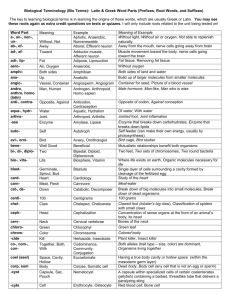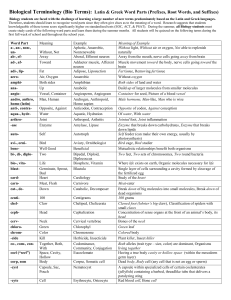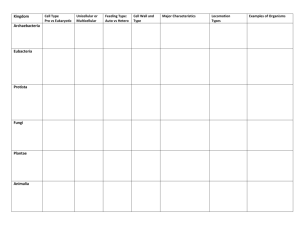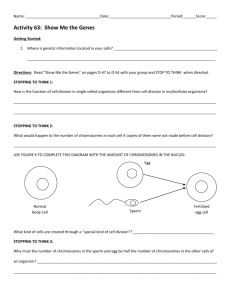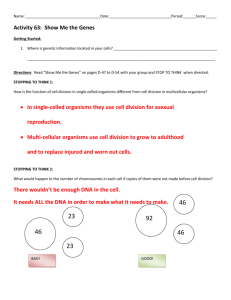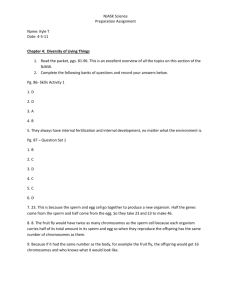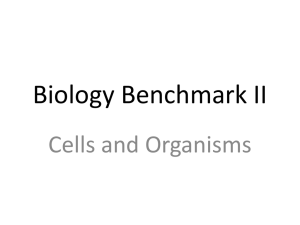Biology Terminology: Latin & Greek Word Parts Study Guide
advertisement
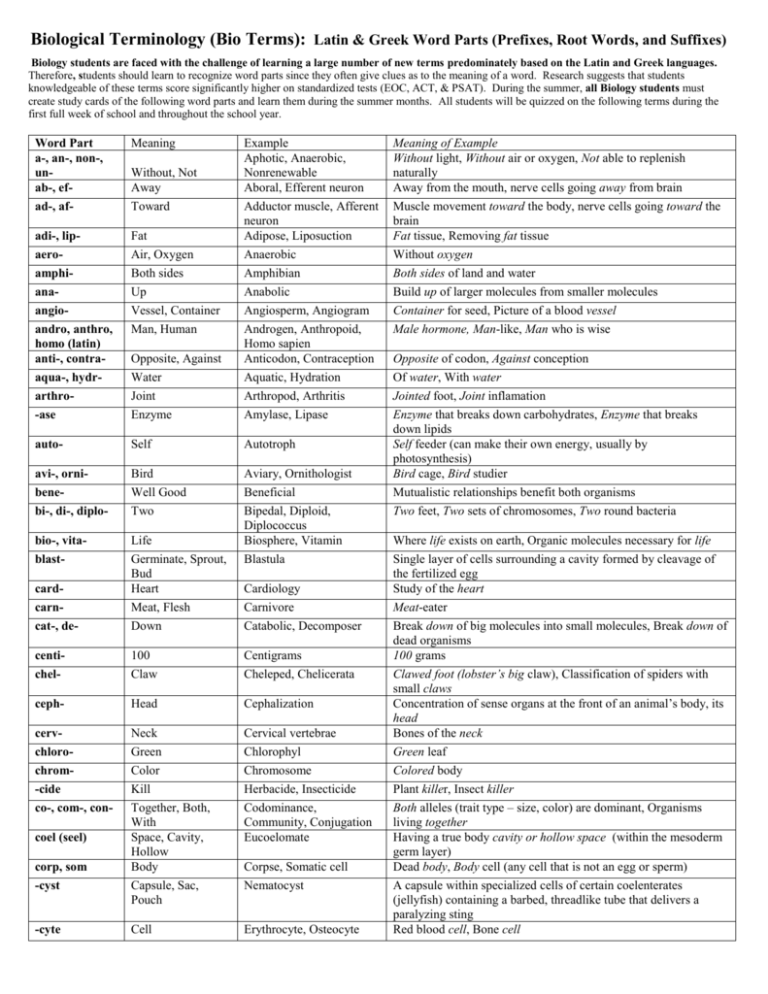
Biological Terminology (Bio Terms): Latin & Greek Word Parts (Prefixes, Root Words, and Suffixes) Biology students are faced with the challenge of learning a large number of new terms predominately based on the Latin and Greek languages. Therefore, students should learn to recognize word parts since they often give clues as to the meaning of a word. Research suggests that students knowledgeable of these terms score significantly higher on standardized tests (EOC, ACT, & PSAT). During the summer, all Biology students must create study cards of the following word parts and learn them during the summer months. All students will be quizzed on the following terms during the first full week of school and throughout the school year. Word Part a-, an-, non-, unab-, efad-, af- Meaning Meaning of Example Without light, Without air or oxygen, Not able to replenish naturally Away from the mouth, nerve cells going away from brain Muscle movement toward the body, nerve cells going toward the brain Fat tissue, Removing fat tissue Without oxygen Both sides of land and water Build up of larger molecules from smaller molecules Container for seed, Picture of a blood vessel Male hormone, Man-like, Man who is wise Opposite, Against Water Example Aphotic, Anaerobic, Nonrenewable Aboral, Efferent neuron Adductor muscle, Afferent neuron Adipose, Liposuction Anaerobic Amphibian Anabolic Angiosperm, Angiogram Androgen, Anthropoid, Homo sapien Anticodon, Contraception Aquatic, Hydration adi-, lipaeroamphianaangioandro, anthro, homo (latin) anti-, contraaqua-, hydr- Fat Air, Oxygen Both sides Up Vessel, Container Man, Human arthro-ase Joint Enzyme Arthropod, Arthritis Amylase, Lipase auto- Self Autotroph avi-, orni- Bird Aviary, Ornithologist Jointed foot, Joint inflamation Enzyme that breaks down carbohydrates, Enzyme that breaks down lipids Self feeder (can make their own energy, usually by photosynthesis) Bird cage, Bird studier benebi-, di-, diplo- Well Good Two Mutualistic relationships benefit both organisms Two feet, Two sets of chromosomes, Two round bacteria bio-, vita- Life Beneficial Bipedal, Diploid, Diplococcus Biosphere, Vitamin blast- Blastula card- Germinate, Sprout, Bud Heart Single layer of cells surrounding a cavity formed by cleavage of the fertilized egg Study of the heart carncat-, de- Meat, Flesh Down Carnivore Catabolic, Decomposer centichel- 100 Claw Centigrams Cheleped, Chelicerata ceph- Head Cephalization cerv- Neck Cervical vertebrae chlorochrom-cide co-, com-, con- Green Color Kill Together, Both, With Space, Cavity, Hollow Body Capsule, Sac, Pouch Chlorophyl Chromosome Herbacide, Insecticide Codominance, Community, Conjugation Eucoelomate Cell Erythrocyte, Osteocyte coel (seel) corp, som -cyst -cyte Without, Not Away Toward Cardiology Corpse, Somatic cell Nematocyst Opposite of codon, Against conception Of water, With water Where life exists on earth, Organic molecules necessary for life Meat-eater Break down of big molecules into small molecules, Break down of dead organisms 100 grams Clawed foot (lobster’s big claw), Classification of spiders with small claws Concentration of sense organs at the front of an animal’s body, its head Bones of the neck Green leaf Colored body Plant killer, Insect killer Both alleles (trait type – size, color) are dominant, Organisms living together Having a true body cavity or hollow space (within the mesoderm germ layer) Dead body, Body cell (any cell that is not an egg or sperm) A capsule within specialized cells of certain coelenterates (jellyfish) containing a barbed, threadlike tube that delivers a paralyzing sting Red blood cell, Bone cell deca-, decideciddendro-, arbordent, dont 10 Cut Off Tree derm Skin Decameter, Deciliter Deciduous Dendrochronology, Arboretum Dental plaque, Orthodontist Epidermis, Ectoderm deutero- Second Deuterostome dia-, dif-, diss- Through, Apart, Across The Back Diarrhea, Dissect, Diffusion Dorsal fin, Notochord Echinoderm, Echidna Ecology ecto-, exo- Spiny Where one lives, Home Out, Outside -emia Blood Condition entomo-, insect epi- Insect Upon, Over, Atop Equ-, iso- Equal, Same Hyperglycemia, Sickle cell anemia Entomologist, Insectivore Epidermis, Epicardium, Epiphytes Isotonic, Equilibrium erthreu- Red True Erythrocyte Eukaryote, Eucoelomate ex-, extra-, exogastr- Out, Outside, Beyond Stomach Extinct, Extracellular, Extrapolation Gastrointestinal (GI) geo hapl-, mono-, uniherb-, -phyte homo (greek) hyper- Earth One Geotropim Haploid, Monosaccharide, Unicellular Herbivore, Epiphyte Homozygous Hypertonic, Hypertension hypo-, sub- Less, Below lingu gnath (nath) gram, -graph Tongue Jaw Written or Picture helix hemhepatoherphetero- Spiral, Coil Blood Liver Reptile Different, Other ichthyes Fish interintra-, endo-itis Between Inside Inflammation of Hypotonic, Hypotension, Subatomic Sublingual Agnathan Electrocardiogram, Sonography Double helix Hemorrhage Hepatitis Herpetologist Heterozygous, Heterotroph Chondrychthyes, Osteichthyes Intercellular Intracellular, Endoderm Dermatitis, Laryngitis karyo, caryo kilo-, mill- Cell Nucleus 1000 Prokaryote, Procaryotic Kilogram, Milliliter dors-, notoechineco- Tooth or Teeth Plant Same More, Excessive Ectoderm, Exoskeleton 10 meters, 10 liters Deciduous trees lose their leaves in the fall Counting tree rings to determine its age, Place where many different trees grow Teeth with patches of bacterial growth, Dr. who straightens teeth Top skin layer, Outer layer of tissue/skin during embryo development Mouth develops second (the anus develops first) Flow through, Cut apart, Across (cell membrane) Fin on the back of a fish, A embryonic structure that will become vertebrae Spiny skin (sea star), (spiny anteater) Study of where organisms live Outer layer of tissue during embryo development, Skeleton on outside of body High blood sugar levels, Sickle shaped red blood cells (should be circular) Insect studier, Insect eater Upon the dermis (skin), Over the heart, Atop a plant Solute levels are equal on both sides of a membrane (inside & outside the cell) Red blood cell True nucleus (protective membrane around DNA), True body cavity Died out, Outside the cell, Beyond known values (on a graph) Stomach and intestines A plant’s response to the earth’s gravity One set of chromosomes, One unit of sugar (glucose), one celled organism Plant eater, Atop a plant Same alleles (form of a gene); More solute (something dissolved in water), Excessive blood pressure Less solute, Below normal blood pressure, Below atoms (protons, neutrons, electrons) Under the tongue A fish without a jaw Print out of the heart’s electrical activity, Taking pictures using sound waves Two strands in a spiraled shape Bleed heavily Inflammation of the liver Study of reptiles (lizards, croc’s, turtles, and snakes) Offspring gets different forms of same trait (Tt), Other feeder (ex. herbivore) Fish with a cartilage skeleton, Fish with a bony skeleton Between cells Inside a cell, Inside layer of a developing embryo Inflammation of the skin, Inflammation of the larynx (voicebox) Cells without a nucleus 1000 grams, 1000th of a liter leuco-, leukoloc logy lys- White Place Study or Science of To Loosen Leucocyte Locus Mycology, Virology Lyses, Cytolysis macro-, mega- Large Mal, dis, dys Bad or Ill marmedi-, mesometa- Sea Middle Change meter Measurement micro- Small morph Shape, Form multi, myria, polymutamyonasal, rhin, probosc neonephr-, renal Many New Kidney Macromolecule, Megafauna Malnutrition, Disease, Dystrophy Marine Biology Medial, Mesoderm Metamorphosis, Metastasis Spirometer, Sphygmomanometer Microsporangia, Microbiology Mesomorph, Metamorphosis Multicellular, Myriapod, Polysaccharide Mutation Myofibril, Fibromyalgia Nasal septum, Rhinoplasty, Proboscis Neonatal Nephron, Renal vein nomoctoma Name 8 Tumor, Swelling Binomial nomenclature Octopus Carcinoma, Lymphoma omni-, toti- All Omnivore, Totipotent oo-, ov- Egg orth- Straight Oogonia, Oviduct, Oviparous Orthoptera, Orthodontist ose, gly, sacchar -osis ostepaleo-, archeo- Sugar Glucose Act, Condition Bone Old, Ancient Acidosis Osteoarthritis, Osteocyte Paleontology, Archeology parapathoped, pod Beside Disease Feet, Foot Parallel, Parapodia Pathogens Centipede, Tetrapod Eats all – plants & animals, All important cell (zygote) – becomes all cells Egg stem cells, Egg carrying tube, Eggs that are hatched outside the mother Straight-winged insect order (grasshoppers), Dr. who straightens teeth A simple sugar or monosaccharide made by photosynthesis in autotrophs Too much acid in body fluids Inflammation where bones meet (joint), Bone cell Study of fossils and the history of earth, Study of ancient civilizations Side by Side, Feet to the side Disease-causing organisms (some bacteria, some viruses, etc.) 100 feet, 4 feet pentperi- 5 Around Pentradial, Pentose Pericardium 5 spokes or rays (sea star has 5 rays/arms); 5 carbon sugar Around the heart phago, troph, vore To Feed or Eat Phagocyte, Autotroph, Carnivore Eating cell (white blood cells), Self-Feeders (photosynthesizers), Meat eater phore photo-, lumin Carry, To Bear Light Color or pigment carrying cell Using light to make glucose, Organisms that can create light phyte, phyto pinn-, plum-, - Plant Wing, Feather, Fin Chromatophore Photosynthesis, Bioluminescence Epiphyte Pinnepedia, Plummage, Change Muscle Nose White blood cell Place on a chromosome where a specific gene is found Study of Fungi, Study of Viruses Process of loosening up or digesting a cell membrane causing cell death Large molecules (lipids, carbohydrates, proteins, nucleic acids), Big animals The tumor was malignant. Study of life in the Sea or Ocean Middle, Middle layer of tissue during embryo development Change in shape or location; Cancer cells that change location (spread), Measures inhalation & exhalation, Measures blood pressure Small spore carriers (male), Study of microbes (bacteria, viruses, etc.) Middle form, Change in shape (tadpole to frog) Organism made of many cells, Organism w/many feet, Many monosaccharides Change in the # or sequence of DNA Muscle cell, Muscle pain Wall dividing nasal cavity, Surgery of reshaping the nose, Elephant’s trunk Newborn Part of the kidney that filters/cleans blood, Vessel taking blood to the kidney Two-name naming system (Homo sapien = Humans) 8 feet Cancer-causing tumor, Tumor of the lymphatic system A plant that grows atop of another plant Using fins for feet (seals), Feather shape & patterns, Straight pter pino- Drink Hymenoptera Pinocytosis platyploid pneumo-, pulmopostpre-, pro prim-, prot- Flat Chromosome Lungs pseudo- False quat-, quad, tetrarerhea, rrhea sal sapr- 4 schizo- Split scope View, See sect, -tom semi-, hemi- Cut One-Half sperm spir Seed Breathe Bisect, Anatomy Semipermeable, Hemisphere Spermacide, Spermatid Inspire, Spiracle stas, stat Unchanging Homeostasis stom-, ora Mouth Stomata, Oral cavity sym-, syn,- sys With, Together taxtelo- Arrange End Symbiosis, Synthesize, System Taxonomy Telophase, Telomeres terr tert-, tritherm Land 3 Heat toxic trans-, per- Poison Across, Through trop, volv Turn, Change Terrestrial ecosystem Tertiary, Trisomy Thermophile, Thermometer Neurotoxin, Hemotoxin Transport, Transdermal, Permeable Phototropism, Evolution ventr- Belly Ventral vore Devour Carnivore zo zyg Animal Yoke (egg + sperm) Zoology Zygote, Homozygous After Before, Forward First Again Flow or Discharge Salt Rotten Platyhelminthes, Platypus Haploid, Diploid Pneumonia, Pulmonary artery Post mortem Prenatal Primary consumer, Protozoa Pseudocoelomate, Pseudopodium Quarternary, Quadiceps, Tetrapod Reproduce Diarrhea Saline Saprotroph Schizocoely, Schizophrenia Microscopic, Macroscopic membraned wings Process of a cell engulfing/drinking liquids or dissolved substances Flatworm, Flat foot One set of chromosomes, Two sets of chromosomes Infection of the lungs, Vessel taking blood from the heart to the lungs After death Before birth 1st organisms to eat producers (herbivores), 1st animal False body cavity (between ecto- & endoderm), False foot (found in amoeba’s) 4th, 4 heads, 4 feet Produce again Frequent passage of loose, watery, soft stools Full of salt or salt containing Feeds on Rotting organic matter/dead organisms (also called decomposers) Cavity formed at the split of the endo- & ectoderm (protostomes), Split mind To see or view something small, To see or view something w/o using a scope Cut in two, To cut up Allows some (1/2), but not all things through, One-half a sphere (ball-shape) Sperm killer, A small or immature sperm To breathe in, Hole found on insects for air to enter and leave (breathing) Unchanging chemical conditions in healthy organisms Hole or mouth in leaves allowing gas exchange (O2 & CO2), Mouth space Organisms living with each other, Put together, Working together A system used to arrange or classify a large number of organisms End of mitosis, End or tip of chromosomes All living and nonliving things in a designated area on land 3rd, 3 bodies (chromosomes) Bacteria that live in hot areas, Heat measuring instrument Poison to the nervous system, Poison in the blood Across a cell membrane, Through the skin, Through a cell membrane Plant’s response of turning toward light, How organisms change over time Belly portion of an organism (portion of a worm that touches the ground) Carnivores devour meat or flesh Study of animals Union of egg & sperm, Zygote receives the same genes from both egg & sperm The best way to study the bio terms is to read (silently & out loud) through your cards both term-first and definition-first so that can you get used to remembering both ways. Go through the entire stack MULTIPLE times day and night. During concentrated study times, go through the cards a first time and place all of the cards answered wrong in a separate pile. Go through the pile of wrongly answered cards, and again place all the cards answered incorrectly in a separate pile. Keep going through the “wrong” pile until there aren’t any cards left that you can’t answer. Repeat this process from the beginning until you are able to go through the entire stack of bio terms without missing any. Give the terms to another person and have them quiz you. If you are able to answer 95% of them right – then CELEBRATE and sleep on it. Review the stack at least 3x’s a week to integrate the terms into long term memory.
